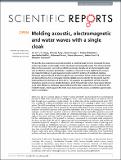Molding acoustic, electromagnetic and water waves with a single cloak
Author(s)
Xu, Jun; Jiang, Xu; Georget, Elodie; Abdeddaim, Redha; Geffrin, Jean-Michel; Farhat, Mohamed; Sabouroux, Pierre; Enoch, Stefan; Guenneau, Sébastien; Fang, Nicholas Xuanlai; ... Show more Show less
DownloadXu-2015-Molding acoustic.pdf (2.319Mb)
PUBLISHER_CC
Publisher with Creative Commons License
Creative Commons Attribution
Terms of use
Metadata
Show full item recordAbstract
We describe two experiments demonstrating that a cylindrical cloak formerly introduced for linear surface liquid waves works equally well for sound and electromagnetic waves. This structured cloak behaves like an acoustic cloak with an effective anisotropic density and an electromagnetic cloak with an effective anisotropic permittivity, respectively. Measured forward scattering for pressure and magnetic fields are in good agreement and provide first evidence of broadband cloaking. Microwave experiments and 3D electromagnetic wave simulations further confirm reduced forward and backscattering when a rectangular metallic obstacle is surrounded by the structured cloak for cloaking frequencies between 2.6 and 7.0 GHz. This suggests, as supported by 2D finite element simulations, sound waves are cloaked between 3 and 8 KHz and linear surface liquid waves between 5 and 16 Hz. Moreover, microwave experiments show the field is reduced by 10 to 30 dB inside the invisibility region, which suggests the multi-wave cloak could be used as a protection against water, sonic or microwaves.
Date issued
2015-06Department
Massachusetts Institute of Technology. Department of Mechanical EngineeringJournal
Scientific Reports
Publisher
Nature Publishing Group
Citation
Xu, Jun, Xu Jiang, Nicholas Fang, Elodie Georget, Redha Abdeddaim, Jean-Michel Geffrin, Mohamed Farhat, Pierre Sabouroux, Stefan Enoch, and Sébastien Guenneau. “Molding Acoustic, Electromagnetic and Water Waves with a Single Cloak.” Scientific Reports 5 (June 9, 2015): 10678.
Version: Final published version
ISSN
2045-2322